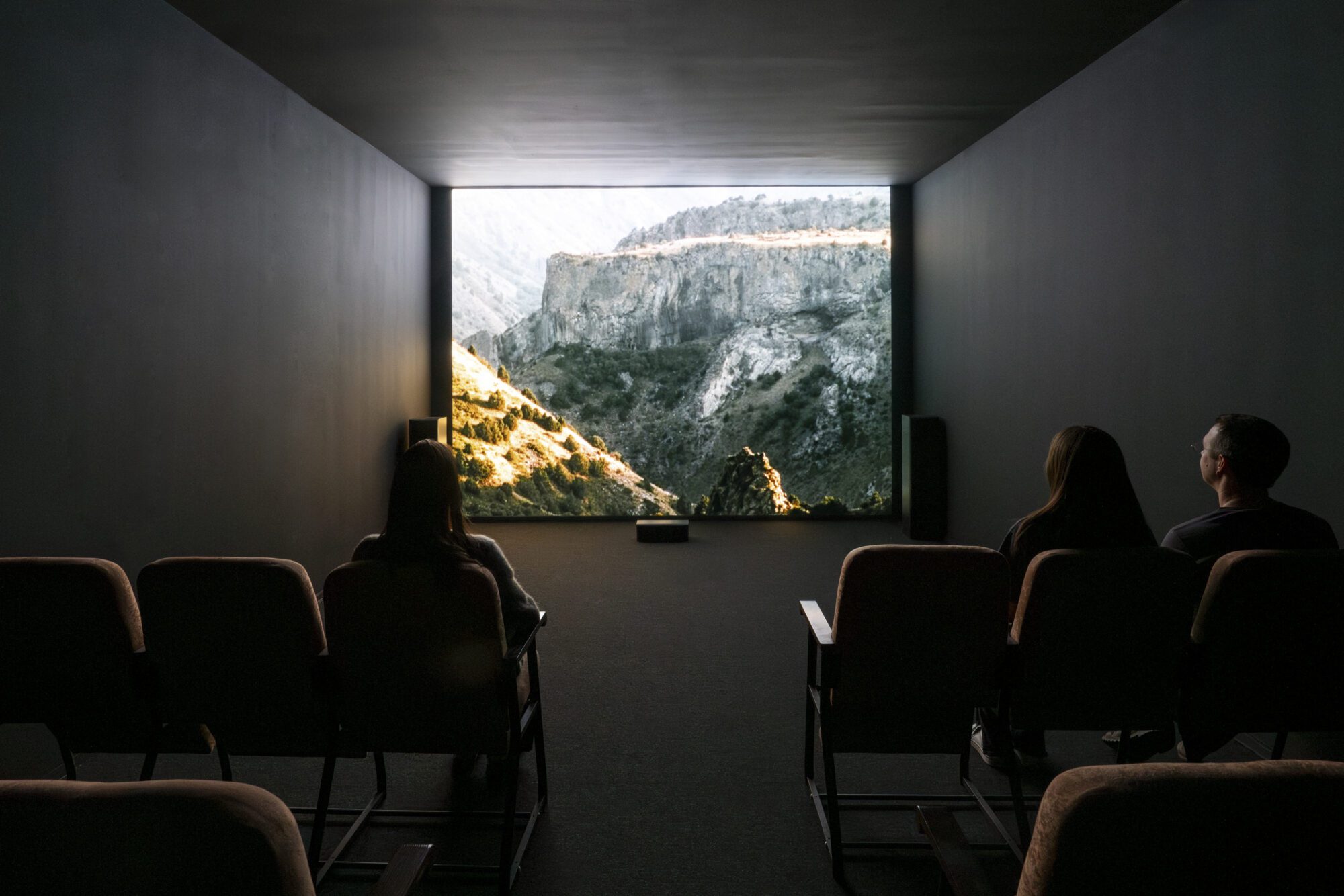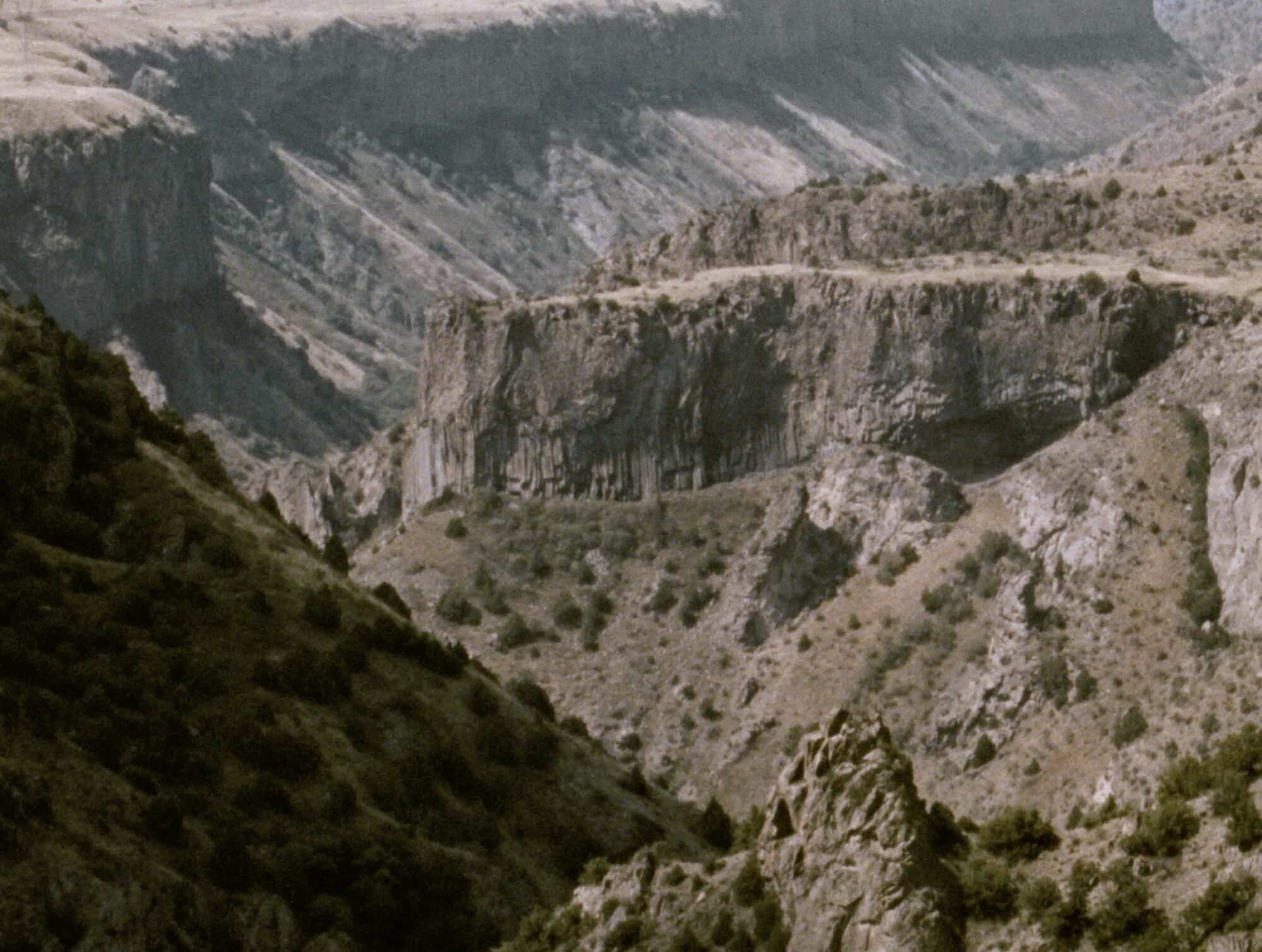





4:3, 4K, 16mm transfer, colour, 5.1-channel sound, 53′, 2024, edition of 3 (+ 2 artist’s proof)
“End Pull” is a cinematic exploration of temporal distortion, speculative narrative and psychoacoustic sound, spanning 53 minutes. Drawing inspiration from Michael Snow’s “Wavelength” (1967) and shot in the Caucasus Mountains, the film features a continuous zoom through an ancient riverbed, unveiling layers of minerals, fictitious narratives and historical distortions.
It was filmed near Jermuk, an Armenian region scarred by the recent war with Azerbaijan, as well as the development of gold mines run by a Russian-British conglomerate, both of which threaten the fragile local water and ecosystems. Using a variety of lenses, the film manually zooms from a wide, kilometres-long opening shot into the minuscule details of the ancient rock strata of the valley. It is accompanied by a continuous soundtrack which uses psychoacoustic sounds to create a hypnotic and dizzying sonic pressure. “End Pull’ is also syncopated by the voices of two ancient demons—Hārut and Mārut—Zoroastrian deities historically associated with water, renewal and the underworld. Awakened from their slumber by the din of artillery and mining, Hārut’s and Mārut’s solitary existence is marked only by a delirious contemplation of death, magic and the poetics of disappearance.
Blending subterranean mythologies with contemporary political events, the film indulges in cinematic and historical time, and the infinite tension between destruction and renewal.
Director’s note:
“I have been fascinated by Michael Snow’s ‘Wavelength’ and the questions it raises for a long time: what happens when cinematic time blends into reality itself? Our bodies seem to be inherently unsettled with a camera lens moving with such deliberate slowness, a gaze almost akin to a sniper’s scope. I often wondered what if this relentless, time-bending gaze wasn’t confined to an interior, but unleashed upon a vast, open landscape? Where would such a controlled and yet transparent movement lead in the wild?
With ‘End Pull’, I decided to use ‘Wavelength’ not as inspiration for a remake, but as a protocol—reading the 1967 piece as a score, essentially. The film was shot over five days in the mountains of Jermuk, Armenia. Working with six different lenses, we manually executed the zoom into the valley following a meticulous technical plan. To achieve that, each new scene begins precisely where the previous lens left off, generating a hypnotic pull that draws the viewer relentlessly closer to the mountain face, even as time shifts across days.
The film’s only two characters, Hārut and Mārut, appear as a counterpoint to this inexorable visual movement, their strange, sometimes delirious conversation almost dissolving into the valley’s echoes. As ancient figures—deities turned demons in some traditions—their story is bound to themes of absence and transformation. I felt they represented an important layer of Armenian and regional history, entangled with myths and cosmologies both half-forgotten and omnipresent. Through Hārut and Mārut’s slumberous dialogue, I wanted to echo the camera’s underlying motive: what remains when things disappear? In the wake of war, absence, and decay—what endures in myths, songs, and the very rocks themselves?
The film’s soundtrack follows a parallel methodology, inspired by Snow’s use of an ascending sine wave that gradually increases in pitch. However, echoing Hārut and Mārut’s association with magic and hypnosis, I also incorporated psychoacoustic effects – sounds designed to be generated within the listener’s brain, not existing solely in the physical soundscape. Much of the soundtrack, therefore, unfolds subjectively within each viewer’s mind, potentially creating unique and unpredictable perceptual experiences. Sound here is conceived as a fluid architecture of time; fluid like a river you can never step into the same way twice.
Ultimately, for me ‘End Pull’ is not a film that answers or even asks clear questions. It is instead a meditation, a hallucinatory cinematic space where time, memory, and myth collide.”
—
Commissioned by the Lyon Biennale, Future Art Generation Prize and Viktor Pinchuk Foundation, with the additional support of Kaunas Biennale, DAAD Berlin and Mondriaan Fonds.
Concept, sound, and writing: Andrius Arutiunian
Concept development and creative producing: Bianca Oana
Director of photography: Louis Braddock Clarke
Colour grading: Julija Steponaitytė
Editing: Andrius Arutiunian, Louis Braddock Clarke, Bianca Oana
Voices: Andrius Arutiunian and Julija Steponaitytė
Reverse transfer to 16mm: Muscle Temple Lab
Sound mastering: Pranas Gudaitis